Fluorescent lights can be an inexpensive lighting option for a small farm operation, but not every fluorescent light is the same. If you’re not using the right kind, you won’t have enough light to grow.
When Should You Use Fluorescent Grow Lights?
Most large-scale and commercial operations use LED lights because they last longer and emit more light. Fluorescent bulbs are also more fragile, meaning a farmer can incur additional labor costs to maintain them, and that may not be worth the time or money. However, the small-scale or hobby farmer may find fluorescent lights to be an economical choice, especially for low-light plants or plants at a low-light stage of development.
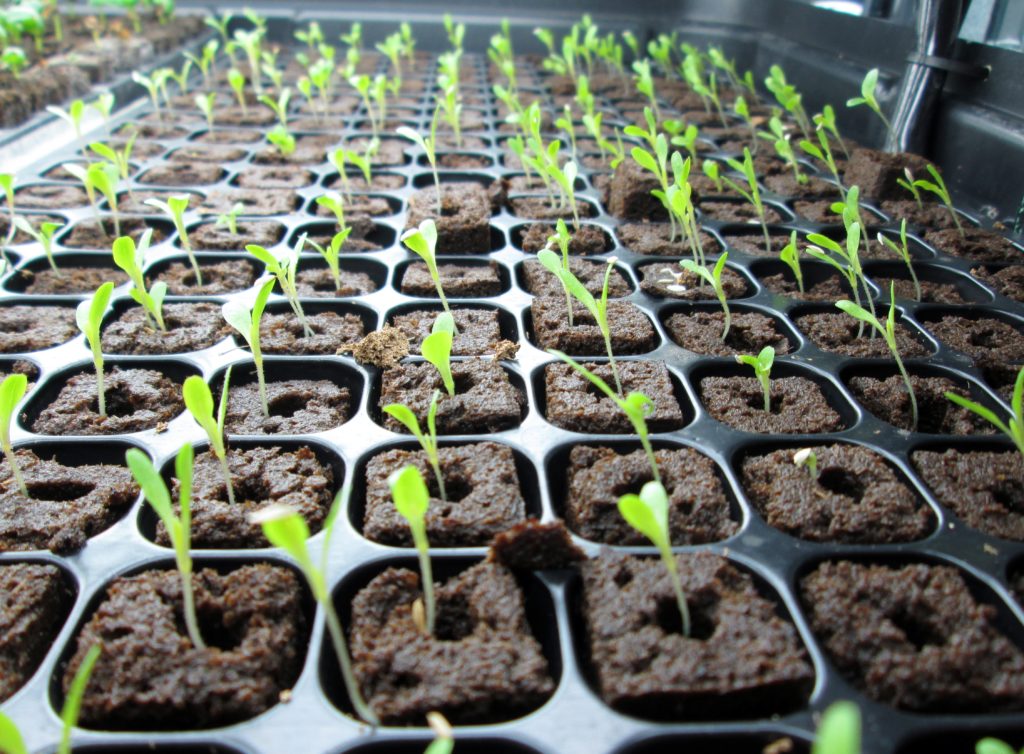
As you scale up in size, make sure fluorescents still make sense cost-wise.
“If you’re doing a commercial operation, I’d look at the economics really, really closely before I committed to fluorescent,” says Dr. Nate Storey.
To make the best economic decision about lighting for your farm, compare both the capital and operational expenses of your lighting options over time. (For example, this is how HID and LED compare.) Don’t forget to factor in replacement and heat-removal costs! Some other options to consider are LED light bars and CoolBars.
Choose a High-Output Fluorescent
All fluorescent lights work in a similar fashion:
- An electric current heats up gas inside the tube, which emits ultraviolet light.
- Meanwhile, a phosphorus coating inside the tube turns that ultraviolet light to visible light.
- A ballast on the back converts the incoming electrical current into a usable form.
You’ll see several numbers on a fluorescent light that give you information about how it works, and help you avoid lights that are too dim. Tubular lights have a “T” rating that tells you the diameter of the tube. T12 lights have that designation because they have a diameter of 12/8 of an inch or 1.5 inches. These tubes were commonly used in indoor lighting applications, but they’re just not very bright, even with a coating to make them full-spectrum. T5 lights are narrower than T12s, with a diameter of 5/8 of an inch. Look for a T5 bulb with an additional “HO” rating, which stands for “high output.” That means the ballast has been adjusted to make them even brighter — and for growing purposes, more efficient.
“This is the preferred [fluorescent] light that we use. This is a very high output light. If you put a T5 next to a T12 and turn them on, you will absolutely see the difference,” Storey says. 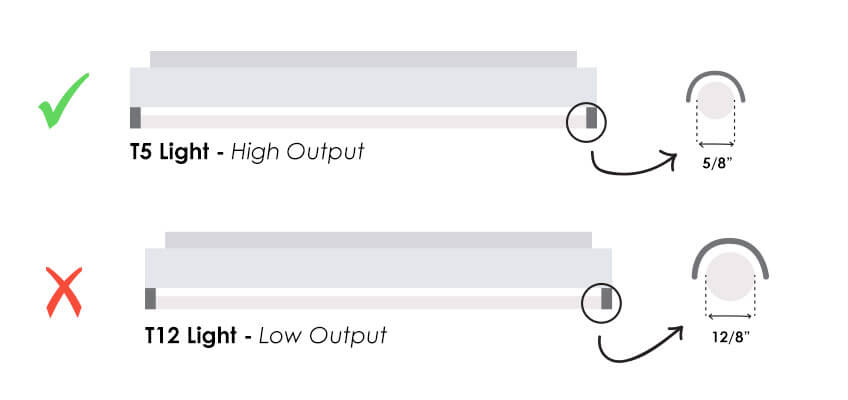 When buying a full-spectrum grow light, you also need to look at the kelvin rating, which indicates how warm the light is. Fluorescent lights in general tend to be bluer, but look for a light ranging from 5,600-6,400 kelvin, which will be indicated on the bulb. On the lower end of that spectrum, the bluer light will give you stockier growth, while the higher rating is great for any kind of vegetation. Fluorescent lights will also come with a wattage rating to tell you how much electricity the bulb uses, usually 54 watts.
When buying a full-spectrum grow light, you also need to look at the kelvin rating, which indicates how warm the light is. Fluorescent lights in general tend to be bluer, but look for a light ranging from 5,600-6,400 kelvin, which will be indicated on the bulb. On the lower end of that spectrum, the bluer light will give you stockier growth, while the higher rating is great for any kind of vegetation. Fluorescent lights will also come with a wattage rating to tell you how much electricity the bulb uses, usually 54 watts.
So when should you use a T12 bulb?
Don’t, unless you find one dirt cheap and you use it only for very small seedlings. Instead, full-spectrum high-output T5 lights are best even for seedlings. They’ll drive growth from the seedling stage through root establishment and until plants are ready for transplanting, at which point you may want to put them under more light. You may even be able to retrofit your fluorescent lights with LED bulbs when time comes. Some farmers use high-output fluorescent lights even for fully grown vegetative crops. If you’re growing plants that are fruiting or flowering, however, LEDs are better.
How much fluorescent light is enough?
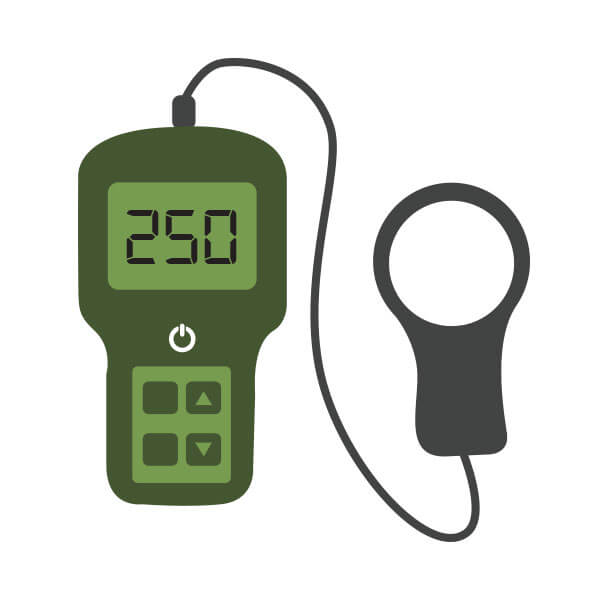 When you’re installing fluorescent lights, you’ll need to measure coverage yourself using a light meter. There are hundreds of manufacturers of fluorescent lights and too many variables between the lights themselves and their installations to know what kind of coverage you’ll get until you line them up. Make sure your coverage is even and your plants are getting sufficient light. A very general recommendation for light is 250+ PAR for mature crops. This can be measured with a PAR meter.
When you’re installing fluorescent lights, you’ll need to measure coverage yourself using a light meter. There are hundreds of manufacturers of fluorescent lights and too many variables between the lights themselves and their installations to know what kind of coverage you’ll get until you line them up. Make sure your coverage is even and your plants are getting sufficient light. A very general recommendation for light is 250+ PAR for mature crops. This can be measured with a PAR meter.
Learn more about indoor crop lighting
Check out The Modern Farmer’s Guide to Indoor Lighting. This guide will give you information straight from farmers about making the best lighting decisions. You’ll learn the basics of plants and their lighting needs, how to measure light, types of lights, how LEDs work and how to compare types of LEDs. 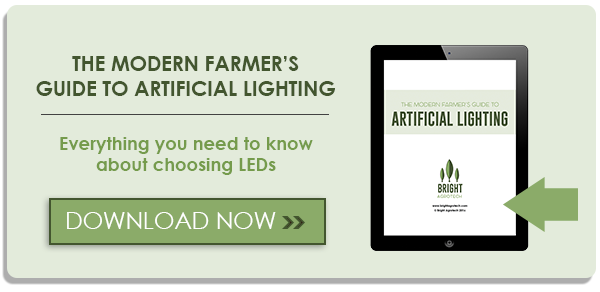

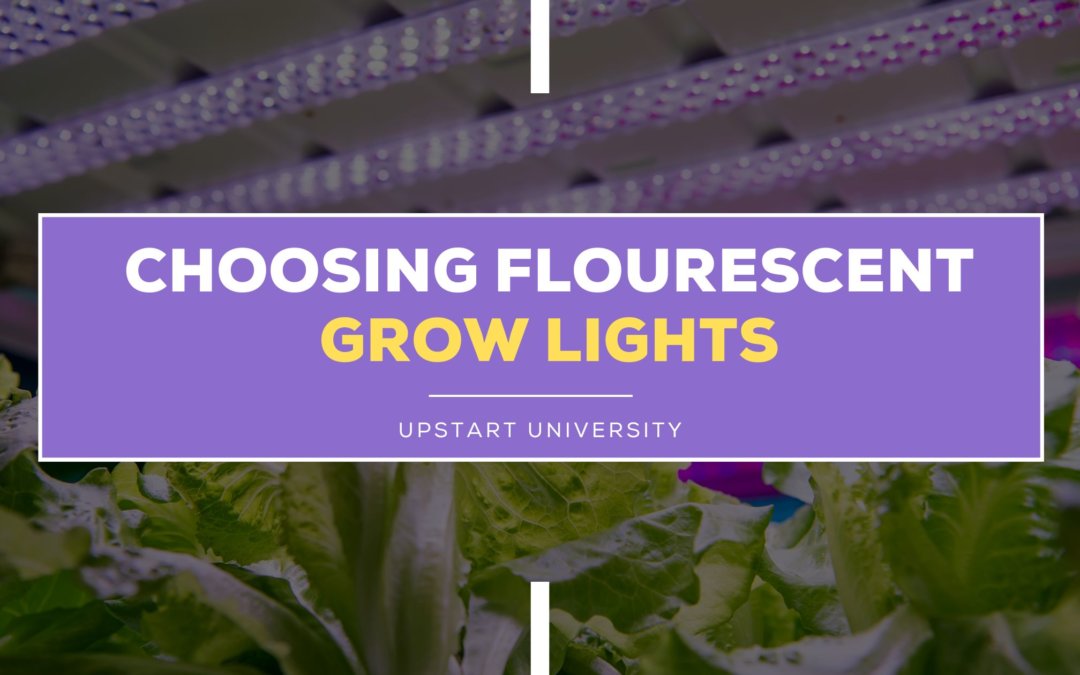

What about T-8’s?
Hey Kathy, can’t say I’ve used T8’s before. Check the bulb for that “H-O” label!
Hi,
I have a budget limitation and confidence, based on applicabilty you listed, FLUORESCENT light will suit my startap farm.
Nate recommends one bulb per tower. so my questions are
1) I’m not very familiar with terminology, but I see PVC trunks fitted from top and bottom to another two with special cut frames. What is the tower – is it a single trunk(if we can name it so) or a set of trunks?
2) What lenght of the bulb will be enough per tower?
Thanks